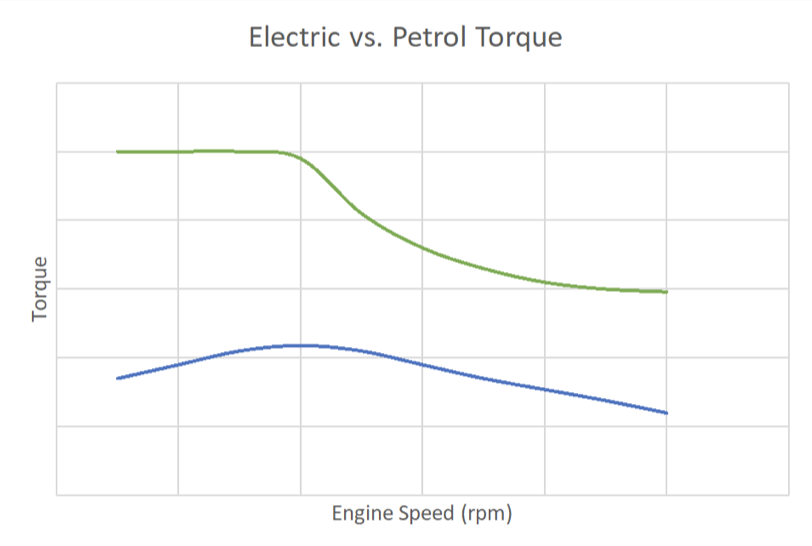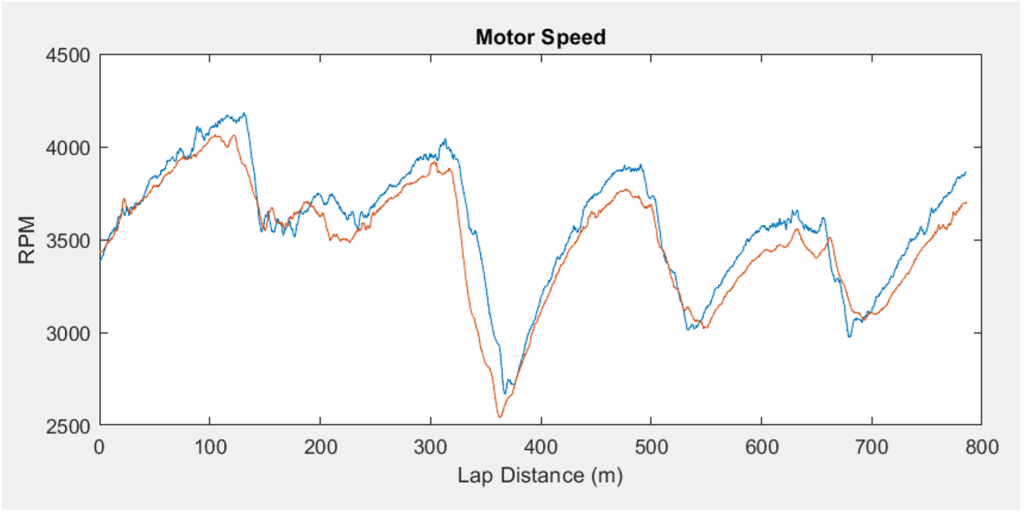THE TECH DIARY:
How to drive an e-kart
A traditional petrol-powered kart is different to an electric kart in more ways than just being more noisy. The differences in power delivery between Rotax, IAME and Honda are well documented, but did you know the power delivery of electric motors is totally different to every petrol engine?
The Difference
When driving an electric kart, the torque (the twisting force from the motor that accelerates the kart) is delivered instantly and is at its maximum at lower motor speeds. This means that when exiting a corner, you get the highest rate of acceleration immediately which helps maintain a higher speed all along the next straight.

A petrol-powered kart, by comparison, has very little torque at low speeds and builds up to a peak about half engine speed, as shown in the graph below. This difference in torque delivery means that when driving an electric kart, more torque is useable for more of the lap.
TKZ drivers will learn in their TKZ STEM lessons that in engineering you don’t get anything for free, the same applied here. The drawback of electric motors having a lot of low-speed torque is that the power is reduced at high speeds.
What this means for drivers
1. Power
Experienced petrol karters who’ve switched to driving a TKZ E-Kart often comment that it feels like “it’s losing power at the top end”. However, the kart doesn’t have an issue - this is normal for electric motors. It feels that way because you’ve done most of your accelerating at the low-speed corner exit phase, and therefore you’re already going faster than a petrol-powered kart and subsequently don’t accelerate as much at the high speed sections of the track.



2. 'Riding the Throttle'
Unlike petrol engines, the electric motors do not have a clutch between the motor and the axle. This means there are fewer moving parts to go wrong, and more energy can be transferred directly to the wheels. Therefore, the traditional habit of riding the throttle during braking to keep the engine speed up and prevent it bogging down simply doesn’t work in an E-Kart. Instead, all you’ll do is stop the brakes from working as well as they should do, as well as wasting charge.
3. Weight Management
The E-karts are heavier than most petrol karts which means managing the weight is more important. Think about how this will affect you in the braking zones, as well as how this affects the kart handling characteristics through the corners and how it behaves when it starts to oversteer.
4. Component Build
E-karts have some different components to the traditional petrol karts and this means their strengths and weaknesses are different. Aggressively riding kerbs can cause problems with some of the electrical components which means there is a risk of the kart temporarily stopping. It may potentially save you a fraction of a second hitting the kerb hard but is it worth the risk of ending your race?
Tips for driving an e-kart
Below are a few tips from the team of experienced drivers here at TKZ:


Tip 1: No bogging down
Because the motors have high torque and don’t ‘bog down’ at low corner speeds, you can use different lines in slow corners compared to a petrol kart, taking a more acute line into the corner while still maintaining a good exit speed. While potentially this may be slower than the optimal racing line in qualifying, while racing in traffic it gives you more opportunities to overtake (or defend!).
The picture shown here demonstrates different lines you could take when you’re looking to overtake the kart in front by getting an earlier apex and faster exit speed.
Tip 2: Don't ride the throttle into corners
Because there’s no clutch on an E-Kart, if you ride the throttle while braking, you are simply wasting charge and making yourself go slower because the brakes are being less effective.
Tip 3: Avoid the kerbs
Some components experience problems when going over large and aggressive kerbs which can result in the power unit shutting down. So, to avoid ending your race early, keep off the kerbs! There are other ways to gain time or speed.
Tip 4: Be gentle on the throttle in the wet (and on cold tyres!)
The massive amounts of torque delivered by the TKZ E-Kart motors mean it’s easy to spin the rear wheels in wet conditions. On corner exits, particularly out of slow corners, try to carefully modulate your pressure on the throttle pedal. Progressively feed in the power rather than just stamping on the pedal.
The same applies if you’re on cold tyres. So remember this when you’re on the first laps of a session or race, as the reality is that it usually takes 3-4 laps for tyres to reach their optimum operating temperature.
Want more?
We look forward to seeing you utilise these tips next time (or the first time) you hit the track with us. If you liked our insight here, join us for on-track practice at circuits around the country to spend time with our experienced instructors to learn more.
READ MORE...
Blog | October 2022
Author: Sammy Bryan | Technology Team
The efficiency of any mechanical system is never going to be identical however, the power output of electric motors is a lot more controllable than petrol engines: petrol engines have…
Stay in the loop
Subscribe to our newsletter to receive updates, competitions and news!

